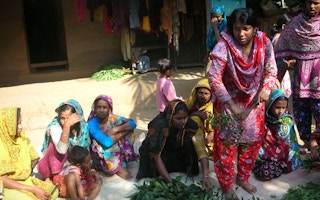A global summit on women and climate, the first of its kind, opened on Sunday, bringing together some 80 activists working on women’s rights, climate change and natural resources, in a bid to build alliances and raise the profile of female environmental leaders.
Experts have long said women and children, especially in developing countries, are most vulnerable to the effects of climate change, and are disproportionately affected.
The four-day summit in Bali - with participants from 37 countries - is focusing on the positive work being done by grassroots women to tackle the issue, despite a dearth of funding.
“Women at the local level have the best and most sustainable solutions to the pressing problem of climate change - but their voices are not being heard, not only internationally but also locally,” said Terry Odendahl, executive director of the Global Greengrants Fund (GGF), one of the event’s organisers, ahead of the summit.
The consequences of global warming are likely to get worse, she stressed.
“If we could raise women’s voices, we would have greater impact to change this dire situation,” she said on the first day of the summit.
“
Multi-billion dollars are coming in through the climate funds, but it’s not going into the local groups. It’s going to the governments
Terry Odendahl, executive director of the Global Greengrants Fund
The environmental and women’s rights movements have operated on parallel paths, and it is time to converge the two, said Emilienne De Leon Aulina, executive director of the International Network of Women’s Funds (INWF). The network of 42 funds around the world that support and promote women’s rights organisations is co-hosting the summit.
For Aleta Baun, an award-winning Indonesian environmental activist, the two movements should not and cannot be separated.
“All our needs, all our access is connected to natural resources … All our food was taken from our garden. Also the cloth that we weave comes from our land,” she said.
Think small
The first day of the summit, held at an environmentally friendly camp and school, heard about the criminalisation of efforts to protect community resources, and the violence faced by women activists who have faced death threats.
Another major theme is women’s struggle to access funds.
“Multi-billion dollars are coming in through the climate funds, but it’s not going into the local groups. It’s going to the governments,” said Odendahl of GGF, which funds grassroots groups working for social and environmental justice.
Even philanthropic foundations that are concerned about climate tend to focus on large grants because of “the idea that climate change is so big we need to do big funds”, she told Thomson Reuters Foundation. “That’s what we are disputing at this summit,” she added.
De Leon Aulina from INWF agreed that women’s activism on natural resources is “very much under-funded”.
Most of the grants GGF make are between $3,000 and $10,000, with a few exceptions. The foundation hands out around $6 million a year - a paltry sum, considering the top three foundations in terms of grants gave more than half a billion dollars in 2011.
Yet Odendahl said the small grants from GGF, which is fifth in the world for the number of human rights grants it makes, have tangible impacts on the ground.
“We see this summit as only the beginning,” she added.

















